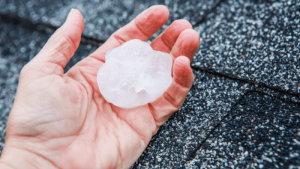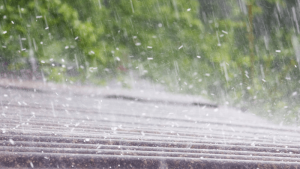Hailstorm Damage to Multi-Family Dwelling Roofs
 Your roof may be one of the most underrated parts of your entire house. It is responsible for keeping you and your family warm, dry, and protected. However, we don’t typically think about the roof over our heads until there is a problem with it.
Your roof may be one of the most underrated parts of your entire house. It is responsible for keeping you and your family warm, dry, and protected. However, we don’t typically think about the roof over our heads until there is a problem with it.
Hailstorms tend to be one of the main culprits of damaging multi-family roofs and causing significant problems. Unfortunately for Texas families, the state ranked number one for hail-related losses between 2017 and 2019. That is according to data from the Insurance Information Institute. In that time, over 1.5 million properties were impacted by hail damage. However, the bad news doesn’t stop there. The state also saw a record 601 major hail events in 2020, proving that hailstorms are a legitimate concern for Texas families.
At Kidd Roofing, our roofing experts are well-versed in spotting hail damage and heading off problems before a major repair is needed. We can pinpoint the sometimes difficult-to-spot damage and add years of life to your existing roof. If a roof is too far damaged to be safely repaired, our team will give you a reasonable replacement cost. Our job is to help you find cost-effective ways to protect your investment.
If your multi-family structure has been damaged by hail, or you suspect that a recent hailstorm has caused isolated damage to your roof, contact the Austin multi-family roofing repair professionals at Kidd Roofing today by calling (512) 671-7791.
What Is Hail?
Like rain, hail is a form of precipitation. Unlike rain, hail consists of solid balls of ice. This ice forms inside thunderstorm updrafts in extremely cold areas of the atmosphere. Hail falls from the sky when a storm’s updraft weakens, or the hailstones become heavy enough to overcome the strength of the storm’s updraft. Most storms drop a range of different-sized hailstones. Balls of ice ranging from the size of a pea up to the size of grapefruit have been reported.
The largest hailstone ever recorded was found in South Dakota. It was 8 inches in diameter and weighed a monstrous 1.9 pounds. While most hailstones do not get that big, even small hailstones can do serious damage.
How Does Hail Cause Roof Damage?
 Hail can cause a wide range of damage. The extent of the damage can depend on the severity of the storm and the size of the hail. Some damage may be purely cosmetic, while other damage can cause structural and functional problems with a roof.
Hail can cause a wide range of damage. The extent of the damage can depend on the severity of the storm and the size of the hail. Some damage may be purely cosmetic, while other damage can cause structural and functional problems with a roof.
Generally, small hailstones will cause little to no exterior damage to a solid roof. However, an older roof or one with existing problems may be damaged even by small granules of hail. Hail the size of a half dollar can cause minor damage to a roof. It may also result in cracks in a home’s exterior siding and shingles.
Larger hailstones, about the size of a walnut, can cause severe roof damage. These stones may shatter shingles and expose the fiberglass mat underneath the shingles. Hail the size of golf balls and tennis balls tend to do the most damage and can be extremely destructive. These hailstones can break windows, dent wood, and damage paint, as well as leave holes and pits in shingles and the roof itself.
After a storm, you may be rightly worried about checking your multi-family dwelling for signs of roof damage. Heading up to the roof of a building can be dangerous, especially if you believe the structural integrity of the roof may be in question. Once a hailstorm is over, contact a professional to inspect your roof.
You may also be able to spot potential signs of damage from the ground. Check for:
- Dented gutters
- Damaged or pitted downspouts
- Damage to siding
- Dents or pits in air conditioners or other outdoor items
- Chipped paint from decks or wooden surfaces
- Shingles that are on the ground
- Visible damage to vents
If you notice any of these signs after a storm, there is a good chance that the roof sustained damage and should be inspected and potentially repaired.
Why You Need to Talk to an Experienced Roofer
Storms come and go, so why do you need your roof inspected after a hailstorm? The answer is simple. It is always best to catch a potential issue before it turns into a major problem. Hail can damage the integrity of your roof. Waiting to have it inspected or make necessary repairs is just kicking the can down the road. Eventually, you are going to have a large repair and a potentially expensive problem on your hands. Repairing isolated hail damage is a cost-effective way to keep your repair costs low and the integrity of your roof interact.
A damaged roof can let in water and animals. If the problem isn’t addressed, you can end up with mold, rot, and dangerous animal waste. These issues can be expensive to repair and pose serious safety risks to your residents.
At Kidd Roofing, we know that maintaining multi-family structures can be a big job. Our Austin team can help by examining your roof, spotting potential problems, and repairing the damage efficiently and cost-effectively. Our crews have seen all types of damage. We know how to spot issues and what it takes to make a roof secure and strong.
Post hailstorm, don’t wait for a fly-by-night roofer to come to you claiming there is a problem. Call Kidd Roofing and get an honest and straightforward estimate.
The Austin Roofers with Kidd Roofing Can Help You with Your Multi-family Hail Repair Needs Today
Multi-family buildings can pose unique challenges. Thankfully, the professionals at Kidd Roofing have a wealth of experience tackling hail damage that impacts a wide variety of structures. Our team can inspect your roof and offer you an honest repair quote. You can also count on our highly qualified team to do the job right.
After a storm or anytime you notice damage, contact us by calling (512) 671-7791. You can also fill out our online inspection request form. We want to help you protect your investment for years to come.








